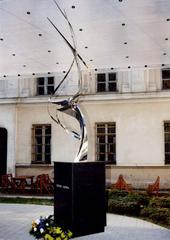O P I N I O N
by Shelly Rybak Pearson
The project occurred to me when I was present during the earthquake in Mexico City in 1984, while visiting my family there. I decided that I wanted to do something to provide a fitting memorial to the destruction of over 95% of the Jewish community of Lithuania during the Holocaust.
My negotiations with the government authorities in Vilnius to erect the monument lasted over six years. During that time, the Lithuanian Embassy in Washington, DC informed me that they had lost the documents which I had submitted to them requesting approval for the installation of the monument. I had to start anew.
Approval was finally received in July, 2000 and it was decided that the monument was to be erected in the courtyard of the former Judenrat of the Vilna Ghetto on Arklių Street behind what was the site of the Lėlė Puppet theatre and the Youth theatre, as being the only suitable site, despite my wish that it be located at a site more accessible to the general public. The inauguration ceremonies were held on October 4th that year during the Vilnius Forum on Holocaust Looted Cultural Assets and was attended by members of the foreign diplomatic community and representatives of Holocaust survivors.

The monument is in a locked courtyard, invisible to the public.
The memorial took the form of a stainless steel sculpture, “The Flame of Hope” which created by the internationally known artist, Leonardo Nierman. His family had been close friends of my father, Morris Rybak in his birthplace near Suwałki (Yiddish Suvalk), and I have known them since my childhood. The project received support and assistance from the United States Commission on the Preservation of America’s Heritage Abroad.
The monument project did not meet with universal appreciation. Professor Dov Levin, a noted Lithuanian historian and a Holocaust survivor living in Israel felt that the monument should be in Israel, this in view of the history of the close cooperation of the Lithuanian paramilitaries and “partisans” with the German Einsatzgruppen in their Holocaust activity beginning in 1941.
In the years following the monument’s installation it became clear to me that my wish that it be viewed by the general Lithuanian public and foreign visitors was not being realized. I learned that access to the site was being made difficult or impossible by the management of the Lėlė Puppet theatre through which anyone attempting to reach the monument site had to pass. I spoke on several occasions to the US Embassy in Vilnius which assured me that they would discuss the problem with the government authorities. I was also told that not only was access to the site limited but that it was allowed to degenerate into a neglected condition covered with rubble and garbage.
During the last two years two members of the United States Congress, Representative Ron Klein and Representative Ted Deutch attempted to enter the site area and were declined admittance.
I am at work on an historical essay covering the activities of Lithuanian paramilitary and the public in general, in support of German forces in the eradication of the Jewish population of northern Lithuania, which began to coincide with the German invasion in the summer of 1941 and culminated in the mass execution of some 10,000 Jews in Žagarė (Yiddish Zháger) during Yom Kippur, 1941. This is a subject of special interest to me because among the victims were the members of my mother’s family in Krūikai (Kruk) where she was born and from which she emigrated to Latin America with my father in 1931. My memories are still filled by the recollection of her weeping in our home in San Jose, Costa Rica, upon hearing of the news in the area of her birthplace.
It was, in great part, these memories that inspired me to erect the Holocaust monument in Vilnius and that cause me particular pain in learning of the neglect and the policy of the Lithuanian government restricting access to it and denying Lithuanian participation in the events which contributed to the elimination of my ancestors.
Recent events in Lithuania do not,provide any reassurance as to the recognition of Lithuanian cooperation in the events of 1941 in support of the anti-Jewish campaign which began even before the arrival of German troops in late June 1941. Public demonstrations with official government sanction on the part of ultra-right wing activists in Vilnius do not lead to any confidence.
It is also my hope (and I continue to work to that end) that the monument which I spent so much time and effort in installing may be moved to a more public location which may arouse in the Lithuanian population an understanding of the events of the Lithuanian Holocaust for which Lithuania bears a degree of culpability. The desire of Lithuania to offer itself as a responsible member of the European community underscores the need for taking responsibility in an honorable, mature and straightforward spirit.
Related:
- The author’s packet of background materials (as PDF).
- John Lantigua in the Palm Beach Post News (15 August 2010).
- Video of John Yearwood’s Miami Herald interview with Shelly Rybak Pearson.
Shelly Rybak Pearson is president of the International Foundation for the Arts.